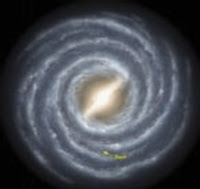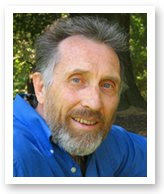 Humankind has been fascinated by the stars ever since we were capable of looking upwards. Ancient civilizations thought the stars were holes punched into the dome (the firmament) that encircled the earth. They thought the firmanent was a hemispheric dome that sat on a round, flat earth.
Humankind has been fascinated by the stars ever since we were capable of looking upwards. Ancient civilizations thought the stars were holes punched into the dome (the firmament) that encircled the earth. They thought the firmanent was a hemispheric dome that sat on a round, flat earth.Since then, people have marveled at the slow, gentle movement of the stars across the sky from east to west. In the summer under a dark sky, we are dazzled by what is called the Milky Way. John Milton, the great seventeenth century poet, described this beautiful heavenly highway in Paradise Lost:
A broad and ample road, whose dust is gold,
And pavement stars,—as stars to thee appear
Seen in the galaxy, that milky way
Which nightly as a circling zone thou seest
Powder’d with stars.
For people who live in the light-filled skies of the modern world, spending the night under a truly dark sky can be daunting. There are so many stars that even if one is familiar with the constellations, they are difficult to find amid all the other stars. It was that dark sky that inspired Henry Wadsworth Longfellow to write, "Blossomed the lovely stars, the forget-me-nots of the angels." These dark sky blossoms are indeed lovely to see.
Some people have the impression that as they look up at the stars, the stars themselves are looking down at them. People who spend time watching, observing and studying the night sky (astronomers) feel a sense of familiarity when a new season brings back stars that have been gone for a period. To some astronomers, it almost feels like a homecoming with a close friend.
Religious people through the ages have thought the stars represented something more than mere lights. For many, they were the lights from some supernatural being that had an influence on human affairs. People who believe in astrology today are convinced the position of the stars can make a difference on what happens on earth. Of course, there is not one shred of evidence (good evidence, not bad evidence) that astrology has anything important to say to us — but that is another topic for another time. Poetry about the sky is much more compelling than the pseudoscience of astrological nonsense.
All of this is an introduction to my activities last week: camping out under the stars with my new telescope and a good friend. The event lasted for four nights. We expected more nights but the weather had a different plan for our lives. My friend, Gary is an astrophotographer which means he takes pictures of different objects in the night sky. It may seem like a simple hobby, but the technology and learning curve can be forbidding. I am always amazed at his persistence and talent for capturing the beauty of things we simply cannot see with our naked eye.
We pitched our tents at a place called Blue Canyon in the California Sierra Nevada mountains. The site we originally went to was rained out at first, so we left. Each night at Blue Canyon was warmer and darker than the previous nights. For those of you who might not be interested in the technical details of what I saw and why, you can leave the blog at this point. The rest of you can follow along.
First of all, I bought a new telescope a few months ago after selling off an old car that had been sitting in my garage for many years. The telescope is made by Celestron and is a Schmidt-Cassegrain type of telescope that has an aperture of eleven inches. Eleven inches is quite respectable in size for amateurs. Most of my eyepieces are made by Televue (unfortunately expensive but they greatly enhance the ability to enjoy the sky). The two that I used most of the time were a 31mm Axiom LX (made by Celestron) and a 17mm Ethos (made by Televue) — the first for a wider field of view, the second for more faintly difficult objects.
To give you an idea of what one looks at through a telescope, let’s break down the
 parts of our universe. Our sun and planets (including our earth) is in the Milky Way galaxy. If we could stand outside our galaxy, it would see a pinwheel made up of millions of stars, some of which would be smaller and some bigger than our sun. Our sun is a very average star when compared to other suns in the galaxy. Many of the suns are doubles, triples or quadruples, meaning they travel through our galaxy as a unit. If a person were on a planet in one of these systems. she would see two or more suns in their sky. Through a telescope we can see many beautiful combinations. Some double stars have contrasting colors, for example a blue star next to a bright yellow star. Tracking down and finding these double stars is something amateur astronomers enjoy doing.
parts of our universe. Our sun and planets (including our earth) is in the Milky Way galaxy. If we could stand outside our galaxy, it would see a pinwheel made up of millions of stars, some of which would be smaller and some bigger than our sun. Our sun is a very average star when compared to other suns in the galaxy. Many of the suns are doubles, triples or quadruples, meaning they travel through our galaxy as a unit. If a person were on a planet in one of these systems. she would see two or more suns in their sky. Through a telescope we can see many beautiful combinations. Some double stars have contrasting colors, for example a blue star next to a bright yellow star. Tracking down and finding these double stars is something amateur astronomers enjoy doing.Our Milky Way galaxy also contains concentrations of dust and gas called nebula. These n
 ebula are the place where stars are born so they are often called star nurseries. If there is a bright star near one of these nebulas, the nebula will light up and can be seen as a large patch of bright, hazy wispiness. Our eyes can only process black and white for dim objects so astrophotographers, like my friend Gary, can expose their cameras for long periods of time and see these nebula in brilliant colors.
ebula are the place where stars are born so they are often called star nurseries. If there is a bright star near one of these nebulas, the nebula will light up and can be seen as a large patch of bright, hazy wispiness. Our eyes can only process black and white for dim objects so astrophotographers, like my friend Gary, can expose their cameras for long periods of time and see these nebula in brilliant colors.We can also look at what is left over after a star has blown up at the end of its
 lifetime (yes, stars are like us because they are born and eventually die). After a star has died we can see the remains of the large amounts of gas expelled during its death throes. The most famous example is something called the Ring Nebula in the constellation Lyra.
lifetime (yes, stars are like us because they are born and eventually die). After a star has died we can see the remains of the large amounts of gas expelled during its death throes. The most famous example is something called the Ring Nebula in the constellation Lyra.As stars are born in their nurseries, they will often stay together for awhile like siblings growing up within a family. The sight of these clusters of stars can be
 stunning through a telescope. Seeing them is like looking at a scattering of diamonds under a very bright light. Each cluster is unlike any other. Because the stars within the cluster are loosely bound together by gravity, they move through our galaxy like a band of adolescents roaming the dark streets of a city.
stunning through a telescope. Seeing them is like looking at a scattering of diamonds under a very bright light. Each cluster is unlike any other. Because the stars within the cluster are loosely bound together by gravity, they move through our galaxy like a band of adolescents roaming the dark streets of a city.One of the more famous open clusters is called the Pleiades and can be easily seen wit
 h the naked eye. Some people have called this cluster the Seven Sisters because there are seven stars (some people only see six bright stars) more prominent than the rest of the cluster. In the Japanese language, the word for "unite" can also refer to the Pleiades star cluster. The word is subaru and you can see the cluster of these six stars in the logo on the back of any Subaru car. Open clusters eventually break up like children who grow up and eventually leave home. The gravitational attraction is not strong so the stars in these clusters eventually wander off on their own. Some astronomers think our sun may have originally been part of a star cluster.
h the naked eye. Some people have called this cluster the Seven Sisters because there are seven stars (some people only see six bright stars) more prominent than the rest of the cluster. In the Japanese language, the word for "unite" can also refer to the Pleiades star cluster. The word is subaru and you can see the cluster of these six stars in the logo on the back of any Subaru car. Open clusters eventually break up like children who grow up and eventually leave home. The gravitational attraction is not strong so the stars in these clusters eventually wander off on their own. Some astronomers think our sun may have originally been part of a star cluster.Another enjoyable sight in the sky is a different kind of star cluster, the globular clus
 ter. Whereas an open cluster can have up to a couple thousand stars, the globulars can include millions of stars packed tightly together. The most powerful amateur telescope can only pick out a small fraction of the individual stars. The stars in these clusters are as old as the galaxy itself. Instead of being found in the galactic disk, these stars roam around the outside of our galaxy as if they are lost with nowhere to go.
ter. Whereas an open cluster can have up to a couple thousand stars, the globulars can include millions of stars packed tightly together. The most powerful amateur telescope can only pick out a small fraction of the individual stars. The stars in these clusters are as old as the galaxy itself. Instead of being found in the galactic disk, these stars roam around the outside of our galaxy as if they are lost with nowhere to go.
The largest objects available for most amateur telescopes are the galaxies. As enormous as our galaxy is, it is merely one of many billions of galaxies in our universe. Galaxies also have different personalities for the observer. Some are small, others are large; some are young, others old; some are beautiful, others are just plain.
During our nights under the stars, I tried to see all of these different types of objects. On the last night, I concentrated on ten globular clusters that sounded interesting. There was a lot of variety. Like other objects, some of the clusters could barely be seen. One of the most stunning globular clusters almost looked like an open cluster with a very tightly packed center. However, the stars were so brilliant that when I looked through the eyepiece, the sight took my breath away.
Amateur astronomy has become a fascinating hobby for me. Dark skies, balmy weather, a good friend, the quiet of night, a telescope and a sky map can be soothing, but unsettling. Our brains do not yet have the capacity to really understand the immense distances involved in our own galaxy, let alone the entire universe. Carl Sagan used to refer to the earth as the "pale blue dot." In comparison to our own planet, we are microscopic beings in a vast universe that we are just beginning to understand. Are we alone? If it takes a thousand years to send a message to another galaxy, will we ever find out? Although humans are fragile, we are also responsible for the continuation of our species. What will the human race be like in another thousand years? One hundred thousand years? A million years? The likely answer is that we will be unrecognizable compared to who we are today.
"Ye quenchless stars! so eloquently bright, Untroubled sentries of the shadowy night." — Robert Montgomery.
"The Earth is a very small stage in a vast cosmic arena ...The Earth is the only world known so far to harbor life. There is nowhere else, at least in the near future, to which our species could migrate. Visit, yes. Settle, not yet. Like it or not, for the moment the Earth is where we make our stand." Carl Sagan, The Pale Blue Dot





